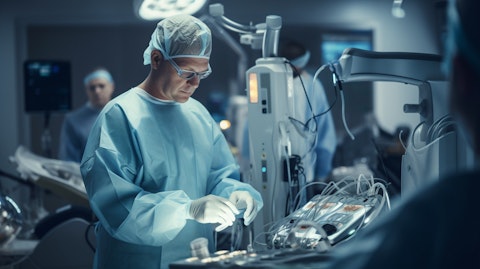Vicarious Surgical Inc. (NYSE:RBOT) Q1 2025 Earnings Call Transcript May 12, 2025
Vicarious Surgical Inc. beats earnings expectations. Reported EPS is $-2.6, expectations were $-2.61.
Operator: Hello everyone, and welcome to the Vicarious Surgical’s 2025 First Quarter Earnings Call. My name is Nadia, and I’ll be coordinating the call today. [Operator Instructions]. I will now hand over to your host, Webb Campbell, Investor Relations, to begin. Webb, please go ahead.
Webb Campbell: Good afternoon. Today, after market close, Vicarious Surgical released financial results for the three months ended March 31st, 2025. A copy of the press release is available on the company’s website. Before we begin, I’d like to remind you that management will make statements during this call that include forward-looking statements within the meaning of federal securities law, which are made pursuant to the safe harbor provision of the Private Securities Litigation Reform Act of 1995. Any statements contained in this call that relate to expectations or predictions of future events, results, or performance are forward-looking statements. All forward-looking statements, including, without limitation, those relating to obtaining approval for the Vicarious Surgical system and the timing of any such approval.
Our operating trends and future financial performance, expense management, market opportunity and commercialization are based upon current estimates and various assumptions. These statements involve material risks and uncertainties that could cause actual results to differ or events to materially differ from those anticipated or implied by these forward-looking statements. Accordingly, you should not place under reliance on these statements. For a list and description of these risks and uncertainties associated with our business, please refer to the risk factors set in our Securities and Exchange Commission filings, including in our most recent form 10-K and form 10-Q. This conference call contains time-sensitive information and is accurate only as of the live broadcast today, May 12th, 2025.
Vicarious Surgical disclaims any intention or obligation, except as required by law, to update or revise any financial projections or forward-looking statements, whether based on new information, feature events or otherwise. Now, I’ll hand the call over to Adam Sachs, Co-Founder and CEO, for prepared remarks. Adam?
Adam Sachs : Thanks, Webb. Good afternoon, everyone, and thank you for joining Vicarious Surgical’s first quarter 2025 earnings call. I’m pleased to be here today alongside Sarah Romano, our Chief Financial Officer. We’re especially delighted to have Sarah with us for her first earnings call as an official member of the Vicarious team, having joined us at the beginning of April. Sarah begins, excuse me, brings decades of financial leadership experience and substantial knowledge from prior CFO positions at innovative businesses and in the health care sector. She has run successful fundraising activities, M&A initiatives and operations strategies in her career. Turning to our recent business progress, it is truly an exciting time Vicarious Surgical.
For the last decade, our vision has been to revolutionize robotic surgery by overcoming the limitations inherent in open laparoscopic and existing robotic approaches. After years of dedicated effort in developing our proprietary decoupled actuating technology and meticulously refining our surgical system to enable minimally invasive procedures through a single small incision, we are just a few quarters away from our biggest milestone yet, our first clinical patients. We anticipate 2025 will be the year Vicarious Surgical evolves into a clinical-stage company and demonstrate the immense value of our single-port surgical system. For the current year, our efforts are directed toward the precise and timely execution of all critical intermediate steps essential for our success in the class.
These include, first, the expansive inventory build out of instrument arms cameras and capital equipment to support our schedule of rigorous testing. Second, the successful completion of all essential performance and safety testing with our surgical system, such as sterility, biocompatibility and electromagnetic compatibility. Third, securing appropriate in-country regulatory approvals to advance clinical work at our respective planned sites. In the first quarter, we successfully built our first patient card and surgeon console for formal preclinical testing and have since begun system integration as well as the construction of our second surgeon console and patient card that will be utilized in our first human cases. Further, our initial instrument sets have completed production and have completed bio burden review with these results in hand, we expect to begin initial biocompatibility and sterility testing on new inventory momentarily, as well as to send additional instruments for sterilization and subsequent essential performance and safety testing.

On the clinical side, we are preparing for our first human cases. We expect to treat a handful of patients at a few sites. The endpoint for these initial patients will align with that of our pivotal trial, focusing on the surgeon’s ability to successfully complete the intended ventral hernia repair. We continue to advance through the approval process required to perform our first clinical procedures. We are maintaining close collaboration with reviewers in this process, providing necessary information for their review of the study design, methodology, and procedures. Beyond our development and clinical progress in the quarter, we are also pleased to announce our latest strategic hospital system partnership with UMass Memorial Medical Center, a premier healthcare system in the greater Boston area and clinical partner of the esteemed University of Massachusetts Chan Medical School.
This collaboration will concentrate on optimizing critical elements of implementing a robotic system, including refining perioperative practices, enhancing surgeon education through mentorship and system testing, and establishing ambassadorship activities to drive best practices and adoption of our version 1.0 system. UMass Memorial’s regional prominence, academic focus, and close proximity to our Waltham headquarters make them an invaluable partner as we work to optimize the integration of our technology into hospital environments. This collaboration adds to our strong set of existing partnerships with several leading healthcare institutions and providers, including HCA Healthcare, University Hospitals, Pittsburgh CREATES, Intermountain Health, and LSU Health New Orleans.
These strategic collaborations, combined with the unwavering commitment of our team, give us a strong conviction in our capability to realize our corporate mission and achieve our objectives for the year. We are increasingly optimistic that the progress made in the first quarter will enable us to showcase the groundbreaking value of our V1.0 system in a clinical setting later this year, a pivotal moment which we are keenly focused on. With that, I’ll now turn the call over to Sarah to review our first quarter financial results.
Sarah Romano : Thank you, Adam. Total operating expenses for the first quarter of 2025 were $15.7 million, a 2% decrease compared to $16.1 million in the first quarter of 2024. R&D expenses for the first quarter of 2025 were $9.4 million, compared to $10 million in the first quarter of ’24. General and administrative expenses for the first quarter of ’25 were $5.3 million, compared to $5 million in the first quarter of ’24, and first quarter 2025 sales and marketing expenses were $1 million, essentially flat from the prior year period. Further, adjusted net loss for the first quarter of ’25 was $15.3 million, or $2.58 per share, as compared to $15.1 million, or also $2.58 per share, in the first quarter of 2024. GAAP net loss for the first quarter of ’25 was $15.4 million, or $2.60 per share.
This compares to a net loss of $17 million, or $2.90 per share in the first quarter of ’24. For a reconciliation of all non-GAAP measures to debt, please review our earnings press release. We ended the first quarter of this year with approximately $37 million of cash, cash equivalents, and short-term investments on our balance sheet. This represents our first quarter cash burn rate of approximately $12 million. We continue to expect full year 2025 cash burn to be approximately $50 million, and we remain committed to disciplined capital allocation. 2025 is off to a strong start, and we look forward to updating you as we progress with our business initiative in the coming quarters. With that, I will turn the call back to Adam for closing remarks.
Adam Sachs : Thanks, Sarah. Vicarious Surgical is on course for a transformative 2025. The team’s solid first quarter performance puts us firmly on the path to achieving our first major clinical milestone later this year. Our achievements are, as ever, a direct result of the unwavering dedication of our team coupled with the invaluable support of our investors and stakeholders. Thank you for your continued belief in Vicarious Surgical. And thank you to everyone who joined the call today. We appreciate your support and look forward to updating you on our continued progress. Nadia, we’re ready for questions.
Operator: [Operator Instructions]. Our first question goes to Ryan Zimmerman of BTIG. Ryan, please go ahead.
Q&A Session
Follow Vicarious Surgical Inc. (NYSE:RBOT)
Follow Vicarious Surgical Inc. (NYSE:RBOT)
Receive real-time insider trading and news alerts
Unidentified Analyst: This is Izzy on for Ryan. Thank you for taking the questions, and Sarah, congrats on your new role here. Just to start out, given your current cash balance right now and the expectations for burn through the year, I was just curious what assurances you can give to investors about your continued ability to fund operations.
Sarah Romano: So, hi. Nice to hear from you. Thank you for the question. So, our main focus is on disciplined spending, on ensuring that we stay within budget while also ensuring that we produce a safe and effective product. So, we’re reviewing all costs, ensuring that our cash is being used in the most effective way possible. Additionally, we are thinking strategically about our financing. We’re currently evaluating all options that are available to us. We do have a very supportive insider base. We believe that they’ll be very supportive going forward as well, and hopefully, some new investors coming to the table as well. With several upcoming exciting milestones ahead, we’re hoping to structure a financing around these. So, I think we’re all very optimistic here with our ability to finance the company.
Unidentified Analyst: Got it. That’s helpful. Thank you. And as we think about the supply, just curious if you guys or how you’re feeling about your ability to supply any remaining components for the V1.0 build, anything that we should be aware of there. Thank you for taking the questions.
Adam Sachs: Yeah. So, last quarter, we did note some challenges with our supply chain. It’s obviously quite a complex supply chain for a fairly complex system overall. That being said, we’ve managed this effectively, and we have not seen any further changes or adjustments in our schedule as a result of supply. So, I would say at the moment, we’re feeling quite good about our supply chain. We have a pretty amazing team that manages the entire supply chain for our business and they’ve been able to do so effectively in the last quarter.
Unidentified Analyst: Got it. Thank you for taking my question.
Adam Sachs: Thank you.
Operator: [Operator Instructions]. And the next question goes to Josh Jennings of TD Cowen. Josh, please go ahead.
Eric Anderson: Hi, this is Eric going for Josh. Thank you for taking the question. I wanted to ask about the technical dossier submission that should be unlocking your ability to conduct first patient testing. I was just hoping for a little more detail on the review timeline expectations. But I think you said in the past that it could be a few months, and I was just hoping we could talk through the assumption there and where it comes from, and also if that factors in some potential questions that you could be receiving from the agency.
Adam Sachs : Yeah, thanks, Eric. I appreciate the question. So, overall, we’re looking around mid this year at filing our technical dossier in country in order to do these first clinical patients. This includes a ton of information, all of the safety testing and performance data that’s required to use our system in the first human cases later this year. So, we’re really excited about this. We’ve made a set of assumptions that enable us to do these first patients later this year. And that’s based on a number of assumptions around other companies with similar products, similar levels of complexity that have filed in similar countries or actually the same country or the same agency in the last year or two. So, we feel fairly confident in these assumptions we have that does take in some time to go back and forth. Hence why we’re filing in the middle of this year and doing those first cases later this year.
Eric Anderson: And then on the hospital partners that you’ve been announcing, and congrats on the recent announcement today, to what extent could they be additive to your development process as we stand right now? Or is that really something that once you reach commercial stage, the benefit of those partners will become evident?
Adam Sachs : So, first, the second part of your question there, 100%. I mean, we are working with these partners, and they are working with us because they’re excited about what we’re doing. And they want to see it in the operating room and be able to use it in the operating room. This is a market that is 96% white space that has incredible opportunity and not nearly enough surgical robotics or robots out in the field today, which gives these hospital systems the opportunity and the availability to purchase our system when we’re on market because of its differentiation and the promise of visualization, dexterity, sensing capabilities, and ability to operate. To answer directly about what we’re working on with them, especially with the latest system with UMass, it’s primarily focused around perioperative workflow and procedures, really making sure not only that we’ve designed a system that is excellent for workflow and able to do procedures in an efficient, streamlined manner, but on top of that, that we’re actually designing the workflow around the system and around what makes sense for the operating room today.
Eric Anderson: That makes sense. Thank you for the question.
Adam Sachs: Thank you.
Operator: [Operator Instructions]. If you have no further questions, I’ll hand back to Adam for any closing comments.
Adam Sachs: I appreciate the questions, everybody. With that, that concludes the call. Thank you.
Operator: This concludes today’s call. Thank you for joining. You may now disconnect your lines.
Follow Vicarious Surgical Inc. (NYSE:RBOT)
Follow Vicarious Surgical Inc. (NYSE:RBOT)
Receive real-time insider trading and news alerts





